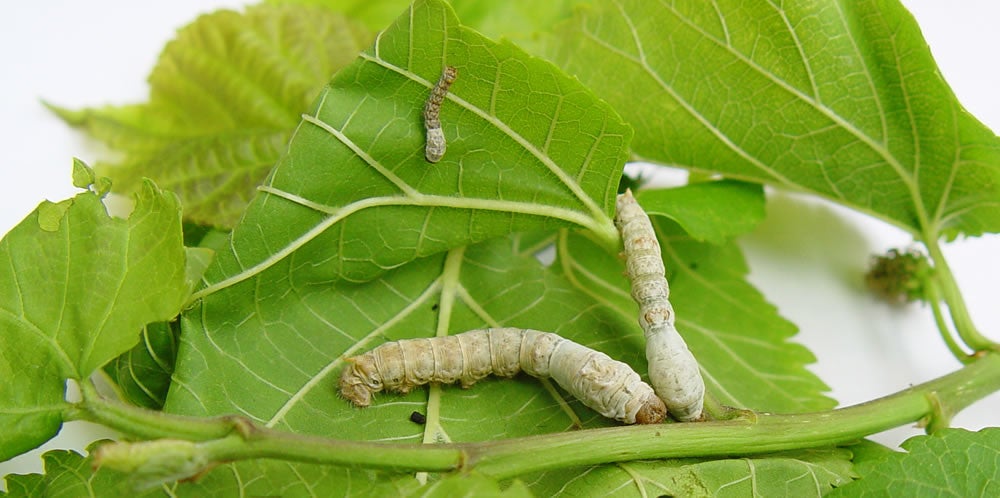Silkworms are touted by some as the “best” feeder insects you can give to your pet reptile. Is this true, or just a marketing gimmick? Let’s take a look about how silkworms compare to other feeder insects, and what those stats mean for your pet reptile.
Nutrition
Silkworms are high in moisture, lower in protein, and low in fat. They also have a solid calcium:phosphorus (Ca:P) ratio.
How do silkworms compare to other feeders in terms of macronutrients?
Silkworms are relatively low in protein. They have more than hornworms, but contain less protein than dubias, crickets, BSFL larvae, superworms, mealworms, waxworms, butterworms, fruit flies, discoids, grasshoppers, lesser mealworms, locusts, giant mealworms, snails, and wax worms.
Silkworms are extremely low in fat. They have more than snails, but contain less fat than dubias, crickets, BSFL larvae, superworms, mealworms, waxworms, butterworms, fruit flies, discoids, grasshoppers, lesser mealworms, locusts, giant mealworms, hornworms, and wax worms.
What about silkworm pupae?
Silkworm pupae are the intermediary stage between silkworm caterpillars and moths, and although the pupae aren’t typically available live, they can be found canned or vacuum-packed. Here are the stats:
- 76% moisture
- 15% protein
- 6% fat
- 2% fiber
- 1% ash
To summarize, silkworm pupae are higher in protein, fat, and fiber than the caterpillars. However, they are still lower on all counts when compared to most common feeder insects.
Cost
One of the most common complaints about silkworms is that they’re expensive. According to a quick survey of the cost per worm from 8 top silkworm distributors in the USA:
- Distributor A — $0.60-0.64
- Distributor B — $0.28-0.60
- Distributor C — $0.85
- Distributor D — $0.50
- Distributor E — $0.50
- Distributor F — $0.60
- Distributor G — $0.75
- Distributor H — $0.28
As you can see, prices range from $0.28 to $0.85 per worm, which is a pretty wide range, and this is likely influenced by the size of the worms and whether they come with food included. However, the most common price is 50-60 cents per worm, which comes out to $50-$60 per 100, not including shipping or bulk discounts.
Let’s compare that cost to other common feeders sold through Dubia.com (prices as of January 2022, cost varies by size):
- Dubia nymphs — $0.18-0.32
- Mealworms — $0.04
- Giant mealworms — $0.12
- Superworms — $0.08-0.10
- Hornworms — $0.31-0.75
- Black soldier fly larvae — $0.03
This makes silkworms one of the most expensive feeders available, comparable only with hornworms followed by dubia. However, the size of hornworms and dubia mean the price you are paying is offset by the amount of food your pet is consuming.
Pros & Cons
Pros
Consistent quality: Silkworms are picky eaters, only eating mulberry leaves or certain specially-formulated commercial substitutes. This means that unlike other types of feeders with less specific dietary needs, their nutritional content is fairly predictable, and you’re not going to get feeders that were raised on junk.
Nutritional variety: Different types of insects assimilate nutrients differently, so when you include silkworms in your reptile’s diet, they are more likely to get a balanced diet. This is especially important for obligate insectivores.
Omega-3 fatty acids: Silkworms contain a significant amount of linolenic acid, which is a polyunsaturated fatty acid. These fatty acids have been shown to have potential beneficial effects on chronic diseases in humans, and regular intake may help suppress cardiovascular disease, cancer, and inflammatory disease. Effects are likely to be similar in reptiles.
Low-energy: Silkworms are low in fat and protein, which means they’re relatively low-calorie per worm. Using them as feeders may help obese reptiles lose weight.
Soft-bodied: Silkworms’ soft bodies make them easier to chew and digest compared to tougher feeders like roaches, mealworms, and black soldier fly larvae.
Sensory enrichment value: Silkworms offer a different flavor and texture from other feeders. Lizards and turtles have taste buds and naturally eat varied diets in the wild, which means they’re likely to appreciate something different in their routine.
Cons
Low-nutrient: Silkworms are low in fat and protein, which means that feeding them to your reptile too often may result in stunted growth.
Small: Silkworms are usually the same size as giant mealworms or smaller, even a large order will get eaten quickly.
Expensive: Feeding mainly silkworms to your reptile is significantly more expensive than using another feeder as your primary. Plus, they’re low-nutrient, so your reptile needs to eat more of them to meet its needs compared to other feeders.
Availability: Silkworms are difficult to produce large-scale, so they’re often out of stock and only seasonally available. They’re also difficult to cultivate at home.
Slow-moving: Silkworms are slow-moving, so they may not stimulate lizards that react only to more mobile feeders like crickets and BSFL.
Conclusion
Are silkworms the best feeder insect?
Truthfully, there’s no such thing as one “best” feeder insect. The best feeders you can provide for your pet reptile is a rotation of at least three different species that have been well-hydrated and gutloaded with a high-quality plant-based bug chow.
Aside from creating more balanced nutrition for your pet, using a variety of feeders can prevent your pet from becoming “addicted” to a certain type of feeder and refusing others. When they’re exposed to a variety of different foods, pet reptiles become more likely to try new things. They’re also more likely to be more enthusiastic about mealtime and less likely to get bored and stop eating for no apparent reason.
References
“Dubia Roaches vs Common Feeder Insects.” Dubia.Com, 1 Dec. 2020, https://dubiaroaches.com/blogs/feeder-insects/dubia-roaches-vs-common-feeder-insects.
Mariah, Healey. “Feeder Insect Nutrition Facts for Reptile Keepers.” ReptiFiles, 18 Nov. 2017, https://reptifiles.com/feeder-insect-nutrition-facts-chart/.
Tomotake, Hiroyuki, et al. “Silkworm Pupae (Bombyx Mori) Are New Sources of High Quality Protein and Lipid.” Journal of Nutritional Science and Vitaminology, no. 6, Center for Academic Publications Japan, 2010, pp. 446–48. Crossref, doi:10.3177/jnsv.56.446.
"Bombyx mori comiendo" by Fernando Cuenca Romero is licensed under CC BY-NC-SA 2.0











